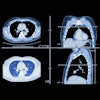VIENNA - Axial CT scans often show disagreement with bronchoscopy regarding the presence of bronchial occlusion, according to researchers from the department of diagnostic and interventional radiology at Korea University in Seoul.
On Sunday Dr. Ok Hee Woo presented the results of a study conducted to determine the extent of mismatched bronchial occlusion between CT and bronchoscopy at the European Congress of Radiology. Her group selected 48 men and 22 women who had total bronchial occlusion at bronchoscopy and also had an initial CT performed.
The interval between CT and bronchoscopy performed on the patients ranged from the same day to eight days later. The CT scans were performed on a spiral CT at a collimation of 7 mm to 10 mm. In cases where there was a mismatch between the bronchoscopy and the CT results, two radiologists and one bronchoscopist reviewed the CT and bronchoscopic findings retrospectively.
Woo and her colleagues found that 15 patients out of 70 showed disagreement between the initial CT scans and bronchoscopic findings. In this subgroup, seven showed patent bronchi, four had disagreement in location of the occlusion, and four made no mention of bronchial anatomy at initial CT review.
The researchers then conducted their retrospective CT review with the radiologists and bronchoscopist. Among the seven patients showing patent bronchi at initial CT records, one showed bronchial occlusion and six patients again showed patent bronchi. Of these 6 patients, 2 had had bronchoscopy performed before their CT, three of them showed bronchial narrowing, and one had bronchial compression.
The researchers also discovered that among the four patients showing a mismatch in location of the occlusion, two patients had bronchial narrowing and two had corrected obstruction level found in the retrospective review of bronchoscopic findings. The four patients who had no mention about bronchial occlusion in their initial CT review showed matched occlusion with bronchoscopy.
Woo’s study found that total bronchial occlusion was missed in 5 of 70 patients by the initial CT scans, compared with 2 missed out of 70 on an initial bronchoscopy. The group also found that a true absence of total bronchial occlusion on retrospective CT review was found in 8 of 70 patients, or 11% of the time.
The researchers recommended that bronchoscopy and CT be performed where there are indications of bronchial occlusion, as axial CT scans alone had a tendency to underestimate both the extent and the severity of bronchial occlusion in comparison with bronchoscopy.
By Jonathan S. BatchelorAuntMinnie.com staff writer
March 5, 2001
Click here to post your comments about this story. Please include the headline of the article in your message.
For more coverage of the European Congress of Radiology, visit our RadCast@ECR special edition.
Copyright © 2001 AuntMinnie.com




















